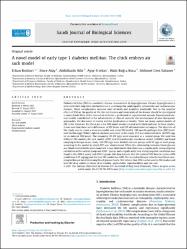A novel model of early type 1 diabetes mellitus: The chick embryo air sack model

View/
Access
info:eu-repo/semantics/openAccessDate
27.08.2021Author
Bozkurt, ErhanAtay, Emre
Bilir, Abdulkadir
Ertekin, Ayşe
Koca, Halit Buğra
Sabaner, Mehmet Cem
Metadata
Show full item recordCitation
Bozkurt, E., Atay, E., Bilir, A., Ertekin, A., Koca, H. B., & Sabaner, M. C. (2021). A novel model of early type 1 diabetes mellitus: The chick embryo air sack model. Saudi Journal of Biological Sciences, 28(10), 5538-5546.Abstract
Diabetes Mellitus (DM) is a metabolic disease characterized by hyperglycemia. Chronic hyperglycemia is
associated with long-term dysfunction such as retinopathy, nephropathy, neuropathy and cardiovascular
diseases. These complications increase rates of death and disability worldwide. Due to the negative
effects of DM on the quality of life, the mechanism and treatments of the disease should be investigated
in more detail. Most of the research in diabetes is performed in experimental animals. Experimental animal models contributed to the advancement of clinical research, the development of new therapeutic
approaches, the discovery of insulin and the purification of insulin. There are many animal models of
DM in the literature. But there are a few DM model studies created with chick embryos. In these studies,
it was seen that there were differences in STZ doses and STZ administration techniques. The objective of
this study was to create a more acceptable and easier DM model. 180 specific pathogen free (SPF) fertilized chicken eggs (White Leghorn chicken) were used in this study. STZ was administered to 160 SPF eggs
for an induced DM model. The remaining 20 SPF eggs were separated as a control group. We used two
different DM models (Air sack model (ASM) and Chorioallantoic membrane model (CAMM)) and blood
sampling technique in our study. 160 SPF eggs were divided into two groups with 80 eggs in each group,
according to the model in which STZ was administered. When the relationship between blood glucose
and blood insulin levels were examined, it was determined that there was a significantly strong negative
correlation in the control group and ASM 1 group; and a significantly very strong negative correlation was
found in the ASM 2 group and ASM 3 group. Our data indicate that the optimal STZ dose to create a DM
model was 0.45 mg/egg and the best DM model was ASM. The second technique to be the best blood sampling technique for determining blood glucose levels. We believe that ASM can be used in DM studies and
anti-DM drug studies in terms of its easebly, applicability, reproducibility and low cost















